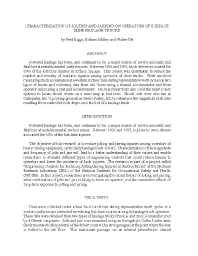Mining Publication: Characterization of Jolting and Jarring on Operators of Surface Mine Haulage Trucks
Original creation date: November 1999
Authors: F Biggs, RE Miller, WK Utt
Presentation at NIOSH Open Industry Briefing, 105th Annual Meeting of Northwest Mining Association, Nov. 30, 1999; :1-10
Powered haulage has been, and continues to be, a major source of severe accidents and fatalities at metal/nonmetal surface mines. Between 1986 and 1997, truck drivers accounted for 63% of the lost-time injuries in surface haulage. This project was undertaken to reduce the number and severity of lost-time injuries among operators of these trucks. Work involved measuring shock acceleration at a western surface mine during representative work cycles on two types of trucks and collecting data from cab floors using a triaxial accelerometer and from operator seats using a seat pad accelerometer. NIOSH researchers also used the mine's GPS systems to locate shock events on a mine map in real time. Shock tests were also run at Caterpillar, Inc.'s, proving grounds in Green Valley, AZ, to determine the magnitude of shocks resulting from controlled rock drops onto the bed of a haulage truck.

Presentation at NIOSH Open Industry Briefing, 105th Annual Meeting of Northwest Mining Association, Nov. 30, 1999; :1-10
- Characteristics of Fugitive Dust Generated from Unpaved Mine Haulage Roads
- A General Framework for Prioritizing Research To Reduce Injuries and Diseases in Mining
- Haulage Truck Dump Site Safety: An Examination of Reported Injuries
- Independent Contractor Trends in the United States Mining Industry
- Machine Injury Prediction by Simulation Using Human Models
- Physical Strength Assessment in Ergonomics
- Potential of Roof Screening to Reduce Workers' Compensation Cost
- Test Results of Collision Warning Systems for Surface Mining Dump Trucks
- Tying Acceleration and GPS Location Information Together To Create a Mine Management Tool
- Verification and Validation of Roof Bolter Simulation Models for Studying Events Between a Machine and its Operator